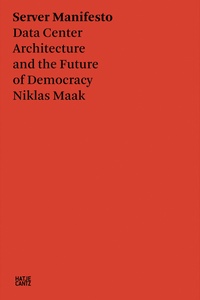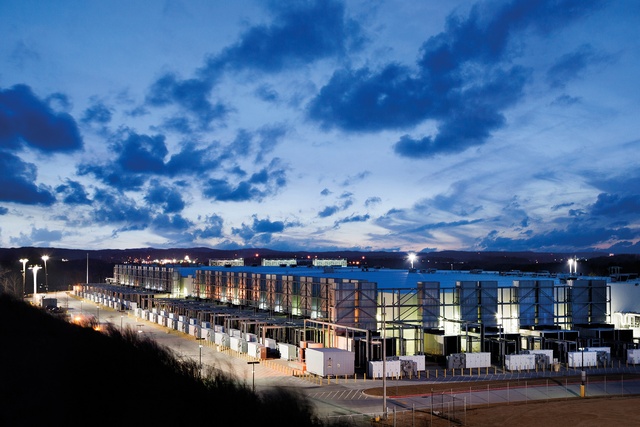Server Manifesto: Data Center Architecture and the Future of Democracy
The ‘commons’ is any finite, valuable resource (such as water, a fishery or a national park) that is collectively enjoyed by a number of people with unfettered access.
The ‘tragedy of the commons’ is that, without shared social structures, cultural practices like kaitiakitanga (guardianship), mutual restraint by consensus or formal rules, people will tend to overuse it, deplete it and end up destroying the value of the resource altogether.1

Niklas Maak, the author of Server Manifesto, writes “data is the single greatest collective treasure of a digital society, the basic material for business and politics”. Data has become the ‘commons’ of our digital age.
The tragedy is that the immense positive potential of data to serve society has been manipulated by algorithm and syphoned off by a handful of tech giants in order to maximise private profit. (The invasive and controlling data-collection practices are described by Shoshana Zuboff in The Age of Surveillance Capitalism.)
“US tech shares are more valuable now than the entire European stock market,” Francesca Bria writes in the opening essay in Server Manifesto. “We need to reclaim digital sovereignty and negotiate a new social contract to use these digital technologies to attain both social and environmental sustainability.” Yes, agreed, but how?
THE DATA COMMONS IS INVISIBLE
The Manifesto goes on: “The hectares of energy-guzzling server farms are the most momentous new building of our time but also are almost invisible.”
In a chapter titled ‘The cloud is burning’, the book describes how two of the data centres of Europe’s largest hosting provider, OVH, burned down in March 2021, taking 3.6 million websites off line. “The cloud burned and the data went up in flames.”

The story of the server farm, which is the brain and actual epicentre of all smart cities, is also a story of the state’s retreat from shaping the digital future.
This little book sets out to consider the ways in which our public places could use open-sourced data positively and discusses how cities must reconsider what makes them smart.
Data commons keep the market open for smaller competitors and participants. “We want competition based on data for services and we want to give all this talent a chance,” Bria, who founded ‘i.lab’, says. At the same time, the focus on data evaluation is shifted from profit maximisation to a public welfare orientation, dedicated to solving social and urban problems, where start-ups collaborate with local co-ops and universities. This is an attempt to avoid delegating the shaping of digital society exclusively to the AI robot-designed value-creation interests of tech corporations.
“Google maintains the monopoly by denying data sovereignty to the citizens whose actual data it is.”
Case studies describe Google’s sister company Sidewalk Labs’ unsatisfactory relationship with Toronto. The challenges in 2020 developing a city district, and the ownership of public data and who develops, controls (and privatises) delivery of civic services and infrastructure, resulted in the citizens of Toronto ‘not being persuaded’ by Sidewalk Labs.
“Google, thanks to its monopoly position, is an example of the private sector that has taken over state services, such as health care, and, because of its data expertise, has eliminated all competitors — much like quasi state corporations in the Eastern Bloc.” Google maintains the monopoly by denying data sovereignty to the citizens whose actual data it is.
DIGITALISATION IS TURNING THE CITY INTO A PARK OF RUINS
If the central typologies that defined the idea of the city for centuries gradually disappear, then many cities could soon “resemble a version of late antique Rome, a modern park of ruins filled with collapsing arcades, overgrown post offices and crumbling office complexes”. The typology of data centres is experiencing rapid growth, as a result of ever-increasing internet use (mobile office work and online shopping, for example). This demand for powerful data infrastructure will drive the transformation of business parks into huge data centres.

“If the infrastructure of a city is organised by private parties subject to the profit drive of their investors, the state not only relinquishes its creative sovereignty then it also deprives itself in the longer term of any kind of design opportunity.”
“What role might, not only the data itself but also the places where it is stored, play for cities and society?”
Niklas Maak is also architecture critic at the Frankfurter Allgemeine Zeitung and guest professor of the Städelschule postgraduate architecture/film school in Frankfurt. The question he asks is: “What role might, not only the data itself but also the places where it is stored, play for cities and society?”
His students’ exploratory speculative visions of server farms and hybrid public and digital commons set out to shock us into considering the future with more alacrity. (How many of us have actually read The Age of Surveillance Capitalism?)
The world is rapidly changing beyond our orthodox public precedents, like Cedric Price’s Fun Palace, 1964, and Piano, Rogers and Rice’s Centre Pompidou, 1977.
Most of the Städelschule student projects, documented in the final of the book’s four chapters, are sketchy, naïve almost, but the collective spatial and sustainable ideas they wrestle with will determine how we might maintain agency in our future cities.
Architects often focus on the object and its detail, at the risk of blurring the bigger-picture relationships. Algorithms are programmed on data that can represent the future only as a continuation of the past.
If we want to continue to see ourselves as guardians of public commons, then this little red book will widen our perspective about the future forces shaping our cities, “and what new collective places a city will need in the age of digitisation”.
POSTSCRIPT
During Covid, there was a fascinating Mediawatch interview with Evan ‘Rabble’ Henshaw-Plath, an American Edmund Hillary Fellow in New Zealand, who had led early tech start-ups. His claim to fame is that he hired Jack Dempsey to start Twitter (now ‘corrupted’ as X). Henshaw-Plath (@rabble is his X handle) is now developingdigital tools people can use, developing opensource, open-society software. He is intent on building an economic, social and political ‘digital commons’.
Henshaw-Plath quotes a conversation he had with Dominic Tarr — an eccentric open-source scripter living on a boat in New Zealand. Tarr said: “modern capitalism believes that what people want is convenience but I think what people want is a sense of control.”
“It’s not about machine learning, or AI, generating the perfect viral media; it’s about groups of people getting together and finding meaning with each other.”
-Even Henshaw-Plath
Henshaw-Plath: “Yes, people want control but they also want connection — we are people and we want to connect — it’s a fundamental human activity. The software we’re building, when we’re building decentralised social media, when we’re building new social media platforms, needs to be about people and human connection, not structuring our world through algorithms,” he says. “It’s not about machine learning, or AI, generating the perfect viral media; it’s about groups of people getting together and finding meaning with each other.”










